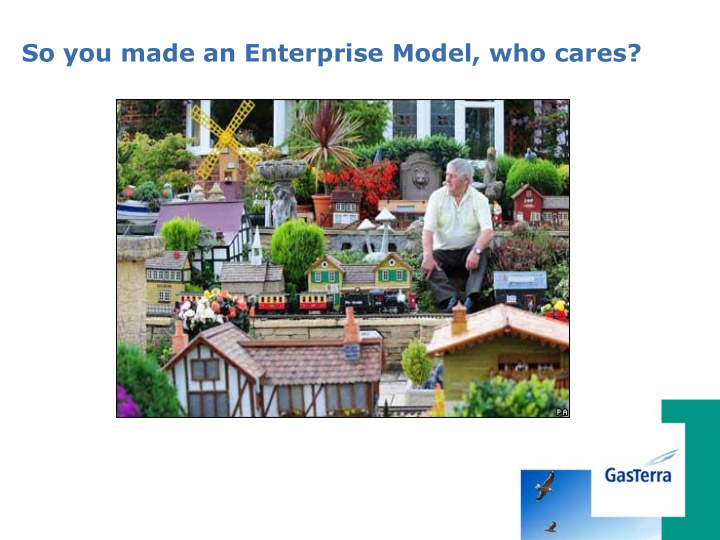



So you made an Enterprise Model, who cares?
Enterprise Model at GasTerra BV Sander Dortland
Contents • GasTerra • History First years, getting started ─ Second period, (re)structuring ─ • Present situation Architecture ─ Modelling ─ • Remarks
GasTerra
GasTerra • Founded in 2005 • Situated in Groningen, Netherlands • Split off from N.V. Nederlandse Gasunie • Gasunie : Transport GasTerra : Trade • 200 employees
GasTerra purchases and sales
GasTerra Gas sales by country In BCM
History, First Years
First years (Organization) Getting started • In 2005 split-off from N.V. Nederlandse Gasunie • Commercial Department Gasunie became GasTerra • Rapidly changing en regulated gas market • Inherited the Gasunie commercial applications (not always fitting) • Small IT department, depending on outsourcing
First years ( Application Landscape) Local construction • Differentiated landscape, applications dedicated to business processes • Projects highly focused on timely delivery of new developments, changes to existing Gasunie legacy systems • Local constructors view. Focus on own process/platform and solve interface problems when they occur
First years (Architecture) Consultancy & Project definition • Delivering expertise in architectural discussions (between and within applications) • Delevering expertise for platform selections • Defining ICT projects (A4 Project Proposals)
First years ( Enterprise model) Ad hoc views • Visio, Powerpoint , Word……
First years, evaluation Enterprise Model : Nobody cares Everybody was working in their own space Negative • Insufficient time and resources for Architecture • Projects are local and in the lead, Architecture follows • “ Enterprise model” is a series of ad hoc pictures Positive • Consultancy is a good start for architecture (if you are able to deliver adequate know how) • Projectportfolio definition also part of Architecture
History, Second period
Second period (Organization) New products, new markets, timeliness • Still very fast changes in markets and products • Timeliness of processes and information becomes important
Second period (Application Landscape) Restructuring • Concern : The fragmented landscape is not able to support the anticipated changes in the future • Main flaws : ─ Increased demand for timeliness ─ Integrated data needed • Review by external consultancy firm Results : ─ Complete renewal of application landscape to cope with future ─ Look for 1 central application for all primary processes ─ 1 large project to be delivered by system integrator
Second period (Application Landscape) Restructuring : Enterprise model
Second period (Architecture function) structuring • Purchase of an Enterprise Modelling tool (BiZZdesign Architect) • Architecture Principles have been developed and developed and enforced in the projects • Tool not used in TerraNova project • Development of models alongside project
Second period (Enterprise model) modelling, modelling • Developing Models in BiZZdesign Architect • Capturing the world (departments, processes, functions, data entities, projects, use cases, …) in detail (result : see first sheet).
Second period (evaluation) Enterprise model : the Architecture function cares Architecture needed the overview Negative • “ Missed the boat ” in using the tool for TerraNova • Models still only used by Architecture • “Tool is a wonderful means to capture as much information as possible ” Positive • Now possible to make consistent models and to report faster • Highest level “Box model” from the tool became known in the business
Present situation, (Architecture and Modelling)
Present situation (Architecture function) Main Activities • Business Information Plan (yearly) ─ Based on NOVIUS Triangle ─ Not a method, a structure ─ Use of the model to deliver pictures • Project Portfolio (yearly) ─ Project Proposals (A4) ─ Use of the model to deliver project context diagrams ─ Resulting Projectlist in the Business Information Plan • Participation in projects ─ Model products mandatory in project documents ─ Consultancy concerning platform choices and solutions ─ Enforcing Architecture Principles
Present situation (Architecture function) Organization Board of Directors Delegate IT Board Release Approve Project BIP Participate & Enforce Architecture Project function Management Submit Proposal Business Department
Present situation (Architecture Function) Business Information plan based on NOVIUS Triangle Business Strategy Policies Levels Structures Actions Projects Business Applications ICT Organization of ICT infrastructure Area’s
Present situation (Enterprise Model) how and when used • Mainly an ICT Architecture tool • Not used by Business, used to clarify things to the Business • Present role : deliver consistent information ( scheme’s ) But : • Other Business functions are starting to use the content Business Continuity for an overview of continuity critical processes ─ Systems development to use the project context info ─ ICT security for an overview of critical processes from the viewpoint of CIA. ─ • Starting to use the model to find relations and connections Project context ─ Link between Critical Processes, supporting Applications, ─ supporting Infrastructure elements
Some examples Project context diagrams Applications in processes (timeperiods) Business Processes Box model
What’s with TOGAF? We use NOVIUS as a structure and built our processes around that We are a relatively small company and an extensive method can very soon lead to overhead Still, the TOGAF book is there, we could use it more to improve our documents and processes We did use the Architectural Principles and that worked very good Looking at the TOGAF part about stakeholder management
Last Remarks 1. Buy a tool, it makes life a lot easier 2. Don’t get carried away in using the tool 3. Never underestimate the power of a big project 4. Be an indispensible part of processes/projects, don’t be an independent function 5. Find other business functions to use your model and deliver products that are relevant to them 6. Make model information available (intranet)
Recommend
More recommend